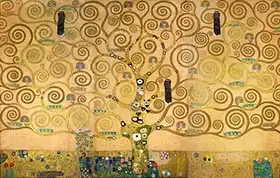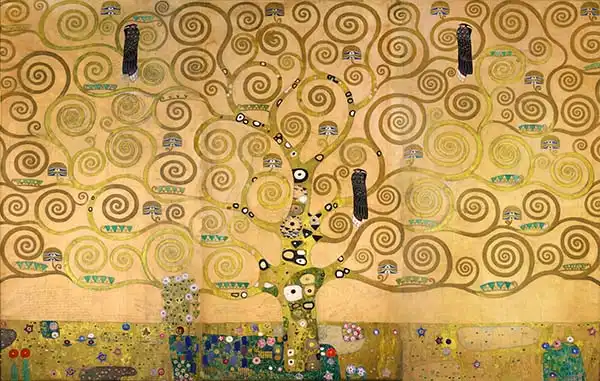Stoclet Frieze - Strom života
Rok vzniku:
1909Provedení:
olej na plátněOriginál uložen:
Österreichisches Museum für Angewandte Kunst, VídeňRozměr originálu:
195x102 cmObraz je součástí výzdoby Palais Stoclet v Bruselu. Jde o mozaiku v jídelně inspirovanou egyptským, byzantským a japonským uměním. Tato série, kterou tiskneme, je tvořena studiemi pro tuto výzdobu. Proto na nich najdete i Klimtovy poznámky k realizaci. Celou sérii tiskneme tak, že jednotlivé panely na sebe přibližně navazuji. Centrální motiv obrazu -
Strom života - pak i v jednom kuse.

Strom života je prostředním obrazem jednoho velkého díla, z levé strany ho ohraničuje
Očekávání, z pravé
Naplnění. Strom života je důležitým symbolem v mnoha filozofiích, náboženstvích i mýtech, představuje spojení mezi nebem, zemí a podsvětím. Mezi
Klimtovými prácemi má jedinečné postavení, jelikož se jedná o jedinou
krajinku z jeho „zlatého období“, kdy vytvářel luxusní díla ve zlatých barvách. Celý obraz je provázaný hlubokou symbolikou. Točící se větve mají vzbuzovat dojem věčnosti a celistvosti života. Celý rozsah stromu - od kořenů až po špičky větví - představují spojení mezi nebem, zemí a podsvětím, jež pro
Klimta znamenalo jakýsi finální determinismus vládnoucí nad každou žijící věcí, která je zrozena, roste a pak se navrací zpět do země. Někteří kritici v obraze namísto nebe a země nacházejí symboliku muže a ženy, jiní lidskou krásu a sílu. Jisté je, že černý pták v centru obrazu k sobě soustřeďuje maximum pozornosti. Symbolizuje, že vše, co někde začíná, také končí.
Klimt namaloval obraz Stoclet Frieze - Strom života v roce 1909. Převládající barvy tohoto obrazu jsou do žluta a jeho formát je podlouhlý. Rozměr originálu je 195x102 cm. Umístěním originálu obrazu je Österreichisches Museum für Angewandte Kunst, Vídeň. Reprodukci tohoto obrazu tiskneme na přání - můžete si zvolit rozměr i provedení reprodukce.
Gustav Klimt (1862 – 1918). Klimt jako malíř reprezentuje nejlepší období Vídně – dobu, kdy tu vznikala díla Sigmunda Freuda či Mahlera a Vídeň byla přinejmenším středoevropským centrem kultury a vzdělání. Klimtovo dílo je kombinací
symbolismu a byzantských rysů, které vytvářejí podtón jeho secesnímu stylu. Klimtovy obrazy mají zvláštní, až úzkostnou atmosféru, často zobrazují freudovskou myšlenku o erotice přítomné v každém lidském pohybu a konání. Maluje dvourozměrně, intenzivními barvami a přitom velice jemně a s vytříbenou důstojností. Mezi Klimtova slavná díla patří
Vodní hadi – dvě ženy se stylizovanými, vzájemně propletenými těly evokujícími neskutečný svět smyslnosti a fantazie. Dále je to
Danaé, dílo inspirované řeckou mytologií zobrazující dívku, které se zmocnil Zeus proměněný ve zlatý déšť (Danaé poté porodila Persea). Jeho obrazy často vzbuzovaly vášně a protesty veřejnosti, a to nejen pro svůj obsah, ale také pro své inovativní malířské postupy – např.
Přítelkyně, obraz dvou žen při milostné schůzce.



























